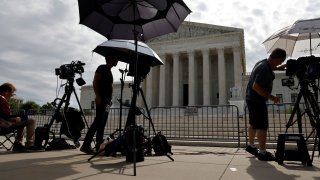
- The Supreme Court ruled in two cases that police officers were entitled to qualified immunity when they used force.
- Qualified immunity protects officers from lawsuits unless it can be shown that they violated "clearly established" rights a reasonable person would know about.
- One case involved an officer putting his knee on a man's back during an arrest while removing a knife from his pocket.
- In the other case, two officers shot and killed a man after he appeared to threaten them with a hammer.
- Police reform advocates have called for an end to qualified immunity, arguing it insulates officers from accountability for wrongdoing.
The Supreme Court in two cases Monday ruled police officers were entitled to protection from being sued over their use of force against suspects.
The unsigned opinions, posted in the court's periodic list of orders, both overturned lower appellate decisions.
One case involved an officer accused of excessive force when he put his knee on a man's back during an arrest, while trying to remove a knife from the man's pocket. In the other case, two officers were sued by the estate of a man whom they shot and killed after he appeared to threaten them with a hammer.
Get Philly local news, weather forecasts, sports and entertainment stories to your inbox. Sign up for NBC Philadelphia newsletters.
The high court said officers in both cases were entitled to qualified immunity. That doctrine protects officers from lawsuits unless it can be shown that they violated "clearly established" rights that a reasonable person would know about.
Police reform advocates have called for an end to qualified immunity, arguing it insulates officers from accountability for wrongdoing. House progressives pushed to include a provision ending the doctrine as part of bipartisan police reform negotiations. Those efforts dissolved last month.
The Supreme Court on Monday first ruled on a case in which police in Union City, California, in 2016 responded to a 911 call alleging Ramon Cortesluna was going to hurt his girlfriend and her two children, who were trapped in another room of her home.
Money Report
As police directed Cortesluna to leave the house and approach them with his hands up, an officer shouted, "he has a knife in his left pocket." Cortesluna lowered his hands and was shot with nonlethal beanbag rounds in the stomach and hip. He got down on the ground, at which point officer Daniel Rivas-Villegas "straddled" him and "placed his left knee on the left side of Cortesluna's back," the court wrote in its opinion.
"Rivas-Villegas was in this position for no more than eight seconds before standing up while continuing to hold Cortesluna's arms," at which point another officer removed the knife and handcuffed Cortesluna, the court said.
Cortesluna sued, arguing Rivas-Villegas used excessive force in violation of the Fourth Amendment. A federal district court sided with the officer, but the U.S. Court of Appeals for the 9th Circuit reversed that decision, ruling that "existing precedent put [Rivas-Villegas] on notice that his conduct constituted excessive force."
The Supreme Court ruled that "to show a violation of clearly established law, Cortesluna must identify a case that put Rivas-Villegas on notice that his specific conduct was unlawful."
He "has not done so," the court's opinion said, and neither he nor the appeals court "identified any Supreme Court case that addresses facts like the ones at issue here."
The other case involved a 2016 police incident in which the ex-wife of Dominic Rollice told 911 that her former husband was drunk in her garage and refusing to leave.
Three officers from the Tahlequah, Oklahoma, Police Department showed up: Josh Girdner, Chase Reed and Brandon Vick. They asked to pat Rollice down for weapons, but he refused, and then turned away from the officers and grabbed a hammer from the garage, according to bodycam footage. Rollice grasped the hammer with both hands and raised it to shoulder level, and refused to drop it when officers shouted for him to let go of it.
Rollice raised the hammer behind his head and "took a stance as if he was about to throw the hammer or charge at the officers," the ruling said. Girdner and Vick then shot Rollice, killing him.
Rollice's estate sued alleging the officers violated his Fourth Amendment right to be free from excessive force. The district court found the use of force was reasonable and that qualified immunity applied.
But the 10th Circuit Court of Appeals differed, ruling that the officers' moves to corner Rollice in the back of the garage led to the use of deadly force.
The Supreme Court reversed that appellate decision, saying none of the precedent cited by the lower court "comes close to establishing that the officers' conduct was unlawful" in this case.
"We have repeatedly told courts not to define clearly established law at too high a level of generality," the high court ruled.
Qualified immunity protects "all but the plainly incompetent or those who knowingly violate the law," according to the opinion, which cited court precedent. It must be clear to "a reasonable officer that his conduct was unlawful in the situation he confronted," the court said.






